Visit Gujarat Rani Ki Vav To Explore An Architectural Wonder In 2025
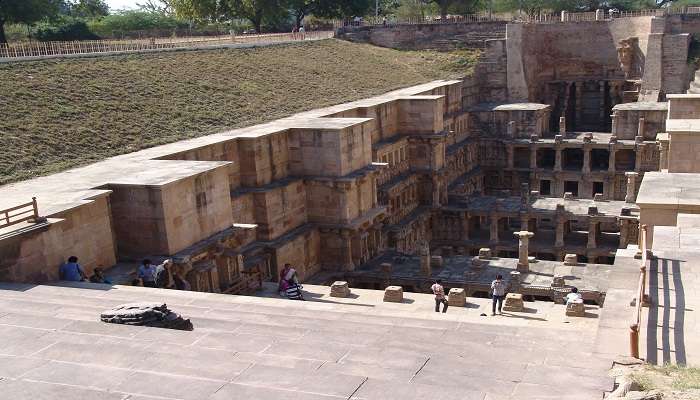
The Rani Ki Vav is an architectural marvel situated on the Saraswati River’s banks in Patan, Gujarat. Rani Ki Vav, also known as Queen’s Stepwell, was declared a UNESCO World Heritage Site. The artistically and brilliantly designed corridors to the well provide a reprieve from the heat and represent India’s rich heritage. This visually appealing historic landmark is a must-visit for any tourist desiring to unfold the varied layers of the region’s cultural gems and traditional aspects. Let’s dive into the depth of Gujarat Rani Ki Vav with this comprehensive guide.
Gujarat Rani Ki Vav History
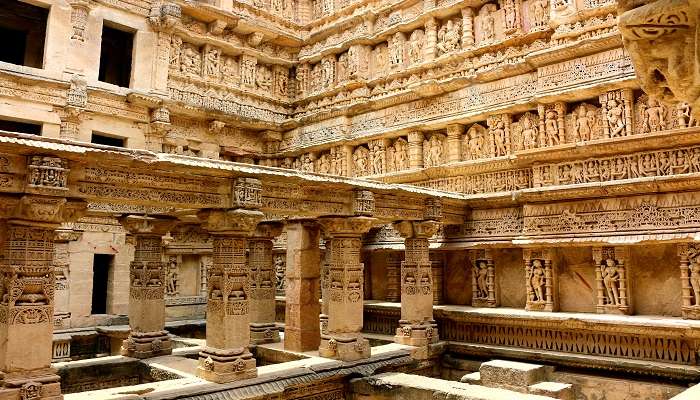
The history of Rani Ki Vav in Gujarat can be traced back to the 11th century. The Queen’s Stepwell was constructed during the Chalukya Dynasty between 1063 and 1068 A.D. The widowed Queen Udaymati built this step well as a tribute to her husband, Bhimdev Solanki, who founded the Solanki Dynasty of Anahilwada Pattan.
It is believed that this ancient man-made marvel was commissioned in 1063 and completed in nearly 20 years. There is a reference in “Prabandha Chintamani,” composed by Merunga Suri in 1304 A.D., to Udaymati building this historical monument. The site was discovered in the 1940s and restored by the Archeological Survey of India in the 1980s.
Also Read: Rann Utsav
Gujarat Rani Ki Vav Architecture
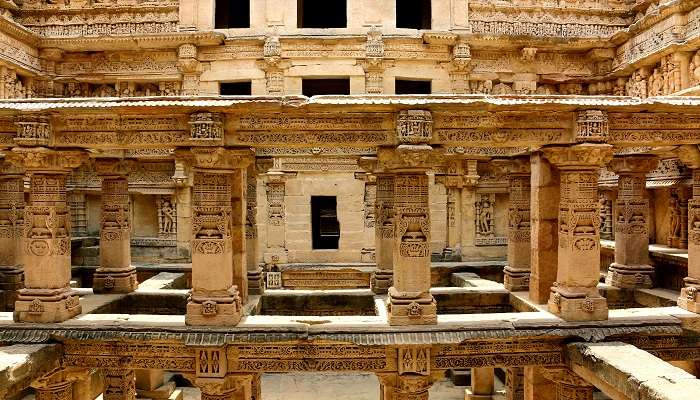
The Gujarat Rani Ki Vav is a famous attraction in Gujarat owing to its architectural brilliance. Its architecture is considered an exceptional and the largest example of medieval architecture by ancient craftsmen in India.
Inspired by the Maru-Gurjara architectural style, the Rani Ki Vav displays the intricate details on the walls of the steepwell. The Rani Ki Vav is divided into seven layers of stairs embellished with a thousand mythological figures. The well is built as an inverted temple that holds a cultural significance. You can find various avatars of Lord Vishnu in the form of Kalki, Rama, Krishna, Narsinh, Vaman, and Varahi depicted on the walls of Rani Ki Vav.
Places To Visit Near Gujarat Rani Ki Vav:
After visiting the fascinating Gujarat Rani Ki Vav, make your way to a plethora of interesting attractions situated within the vicinity of this marvellous attraction. Explore some of the most prominent landmarks, which allow you to delve further and discover Gujarat’s rich labyrinth of culture, history, and architecture.
1. Patan Patola
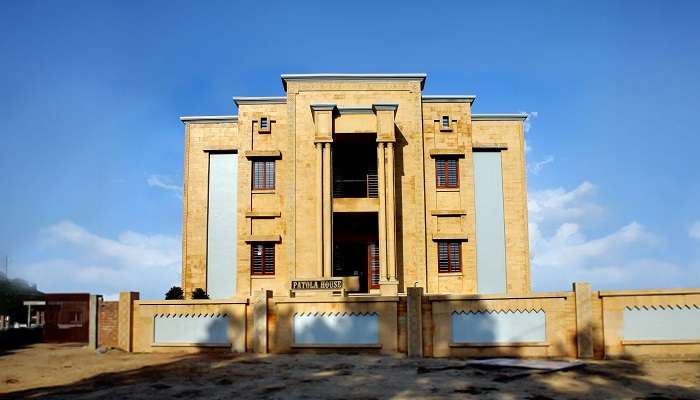
Nestled in the city of Patan, Gujarat, The Patan Patola Heritage Museum displays the traditional Patola silk weaving, a century-old practice in Patan. Patola sarees are known for their intricate double ikat patterns and vibrant colors that make the patola costly.
The Patan Patola Museum exhibits a collection of Patola sarees that show the evolution of craftsmanship from different generations. A visit to this museum will give you an insight into the intricate weaving process, from dyeing the yarn to meticulously aligning the threads to achieve symmetrical patterns. The Patan Patola Museum also conducts educational programs to promote awareness of Patola weaving among tourists.
Distance: 700 meters
Timings: 10:00 A.M.-6:00 P.M.
Entry Fees: Free
Related Post: Romantic Places In Gujarat
2. Patan Fort

The charming Patan Fort is perched on a hilltop of Patan town in Gujarat. Also known as the Fort of Rani ki Vav, it is an architectural phenomenon that you should visit on your trip to Gujarat. The Fort was built in the 11th century during the rule of the Chalukya Dynasty.
The Fort served as a royal residence for the Patans and a military outpost for Patan rulers. Once you enter, you will be awe-struck by its interior architecture. The central doorway, known as Darwaza, is embellished with beautiful patterns. The halls, chambers, and apartments are decorated with wooden carvings that show the essence of medieval architecture.
Distance: 1.5 kilometers
Timings: 24/7
Entry Fee: Free
3. Trikam Barot Ni Nav
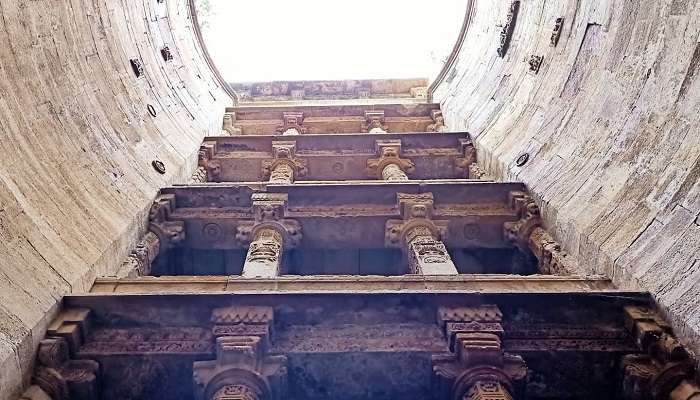
The Trikat Barot Ni Nav, located in Patan town, Gujarat, exhibits the rich cultural heritage of the step wells in the Patan region. The Trikam Barot Ni Nav, also known as Trikam Barot Bav, serves as a vital water source for the local community and exemplifies the fine architecture of ancient Indian artisans.
Built in the 11th century during the reign of the Solanki Dynasty, the step well served as a water source for the local community and a place for social gatherings and interaction. The vav’s walls are embellished with sculpted idols and mythological narratives that reflect the essence of that era.
Distance: 2.3 kilometers
Timings: 24/7
Entry Fee: No entry Fee
Related Post: Festivals In Gujarat
4. Modhera Sun Temple

Situated in the picturesque town of Modhera, the Sun Temple is a testament to medieval architecture. It is dedicated to the Hindu deity Surya and provides a pristine environment for visitors who come here to pray and witness ancient Indian architecture.
In the 11th century, King Bhimdev I, the ruler of the Solanki Dynasty, decided to build this magnificent temple as a tribute to the Sun God “Surya.” The Sun Temple’s architecture is divided into three main divisions: Surya Kund (Sun Tank), Sabha Mandap (assembly hall), and Guda Mandap (sanctum sanatorium). All three sections of the Sun Temple are intricately designed with woodwork and carved pillars.
Distance: 36.1 kilometers
Timings: 7:00 A.M.-6:00 P.M.
Entry Fee: Free
Related Post: Places To Visit In Vadodara In 1 Day
5. Rudra Mahalaya
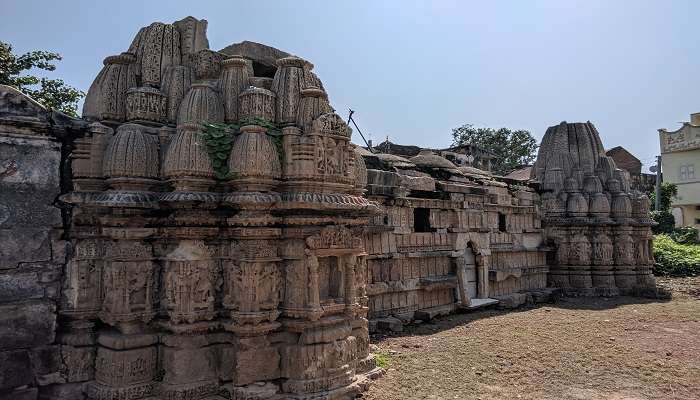
Another pinnacle of ancient architecture in India is the Rudra Mahalaya. The Rudra Mahalaya is located in the historical Siddhpur Town in Gujarat. The alluring Rudra Mahalaya was built in the 10th century during the Chalukya Dynasty. The Rudra Mahalaya was dedicated to Lord Shiva (a Hindu deity).
The architecture of the Rudra Mahalaya attracts tourists from different regions. The Temple consists of multiple shrines, halls, and a courtyard. Its architecture is a unique fusion of Hindu, Jain, and Islamic styles. On your trip to Gujarat, grab the opportunity to explore this majestic temple.
Distance: 33.3 kilometers
Timings: 8:45 A.M.- 7:15 A.M.
Entry Fee: No entry Fee
You May Also Like To Read: Nargol Beach
Gujarat Rani Ki Vav can be on your trip to Gujarat itinerary. It is one of the UNESCO World Heritage sites in Patan town, Gujarat that showcases the true essence of architecture from the Indian artisans during the Solanki dynasty. The architecture will give you a glimpse of life during that period. The Gujarat Rani Ki Vav is a must-visit tourist attraction in Gujarat.
For our editorial codes of conduct and copyright disclaimer, please click here.
Cover Image Credit :Anilharnal for wikimedia commons
Frequently Asked Questions About Gujarat Rani Ki Vav
What are the timings for Gujarat Rani Ki Vav?
The Gujarat Rani Ki Vav is open to tourists from 0 A.M. to 06:00 P.M. It is recommended that tourists visit early in the morning because it is less crowded than on other days.
How to reach Gujarat Rani Ki Vav?
By Road: Intercity buses are available from Ahmedabad which will hardly take 3.5 hours to reach Patan and if you board a bus from Mehsana it will take 1 hour to reach By Train: Patan's railway connects to other cities and the nearest, and the closest is Mehsana, which is 1 hour from Patan town. By Air: The Ahmedabad International Airport is the nearest airport to Patan town (125 kilometers).
What are the facilities available for tourists at Gujarat Rani Ki Vav?
Gujarat Rani Ki Vav has various facilities available for tourists such as a visitor information center, restrooms, a car parking area, etc.
What is the dress code for visiting Rani Ki Vav?
There is no mandatory dress code for visiting Guj for visiting Ki Vav. However, modesty is recommended to respect local traditions, as many people consider it a sacred place.
What is the best time to visit Gujarat Rani Ki Vav?
The best time to visit Gujarat Rani Ki Vav is between September and March, as the weather is pleasant and not too hot. You won't have to worry about mid-temperature or getting sweaty.
People Also Read:
Places To Visit In Gujarat Historical Places In Gujarat Things To Do In Gujarat

With a passion for travelling, and carving beautiful stories of stunning locations I chose my profession as a content writer. The unique blend of creativity and strategy ensures that each narrative takes readers on a journey to their desired destination. With distinct locations and unique vibes, I strive to deliver captivating content that speaks to the hearts of readers.











